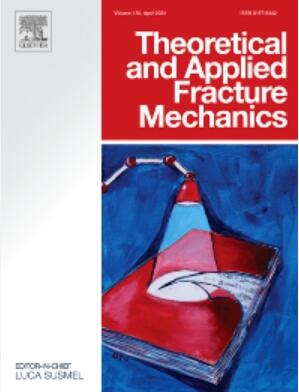空腔位置和数量对 3D 打印马蹄形隧道试样失效机制的影响:实验和数值模拟
IF 5
2区 工程技术
Q1 ENGINEERING, MECHANICAL
引用次数: 0
摘要
本文章由计算机程序翻译,如有差异,请以英文原文为准。
Effects of cavity locations and numbers on the failure mechanisms of 3D printing horseshoe-shaped tunnel specimens: Experiments and numerical simulations
The presence of voids behind the tunnel lining holds crucial significance for the long-term safe and steady operation of tunnels. To explore this impact comprehensively, the present research utilizes sand 3D printing technology to fabricate horseshoe-shaped tunnel specimens featuring diverse void configurations (namely, single void, double voids, and no voids). Subsequently, uniaxial compression tests are carried out to examine how these voids influence the mechanical characteristics and failure modes of the tunnels. Surface strain distribution is meticulously recorded through Digital Image Correlation (DIC). The Discrete Element Method (PFC2D) was employed to simulate specimen failure processes and analyze damage mechanisms. The stress–strain curves of rock specimens exhibit four distinct phases: the compaction stage, the elastic deformation stage, the plastic deformation stage, and the specimen’s terminal failure stage. It is substantiated that the position of voids exerts a substantial impact on the peak strength of the tunnel models. With regard to the single void specimen, when the angle α ranges from 0° to 180°, the peak strength displays a tendency of increasing initially, then declining, and finally increasing. An analogous pattern is noticed in the double voids specimen when the angle β varies from 45° to 180°. Herein, the peak strength displays a consecutive pattern of first rising, then decreasing, and ultimately rising. Cracks were observed to emerge at the crown of the arch as well as along the perimeter of the tunnel’s base in the specimen without voids. Moreover, it was discovered that the paths along which cracks extended of both single-void and double-void specimens were restricted by the alignment of the voids. This led to the emergence of diverse crack configurations, namely: the Top main crack, the Underside main crack, the Side crack, and the Corner crack. It has been demonstrated that the numerical simulation of the specimen cracking process is highly consistent with the experimental findings. Ultimately, the crack initiation mechanisms are detailly discussed. This research offers a valuable benchmark for grasping the influence exerted by voids behind tunnel linings on the operational safety of tunnels. Moreover, it serves as a directional compass for damage anticipation and disaster prevention as well as mitigation within the realm of underground engineering.
求助全文
通过发布文献求助,成功后即可免费获取论文全文。
去求助
来源期刊

Theoretical and Applied Fracture Mechanics
工程技术-工程:机械
CiteScore
8.40
自引率
18.90%
发文量
435
审稿时长
37 days
期刊介绍:
Theoretical and Applied Fracture Mechanics'' aims & scopes have been re-designed to cover both the theoretical, applied, and numerical aspects associated with those cracking related phenomena taking place, at a micro-, meso-, and macroscopic level, in materials/components/structures of any kind.
The journal aims to cover the cracking/mechanical behaviour of materials/components/structures in those situations involving both time-independent and time-dependent system of external forces/moments (such as, for instance, quasi-static, impulsive, impact, blasting, creep, contact, and fatigue loading). Since, under the above circumstances, the mechanical behaviour of cracked materials/components/structures is also affected by the environmental conditions, the journal would consider also those theoretical/experimental research works investigating the effect of external variables such as, for instance, the effect of corrosive environments as well as of high/low-temperature.
 求助内容:
求助内容: 应助结果提醒方式:
应助结果提醒方式:


